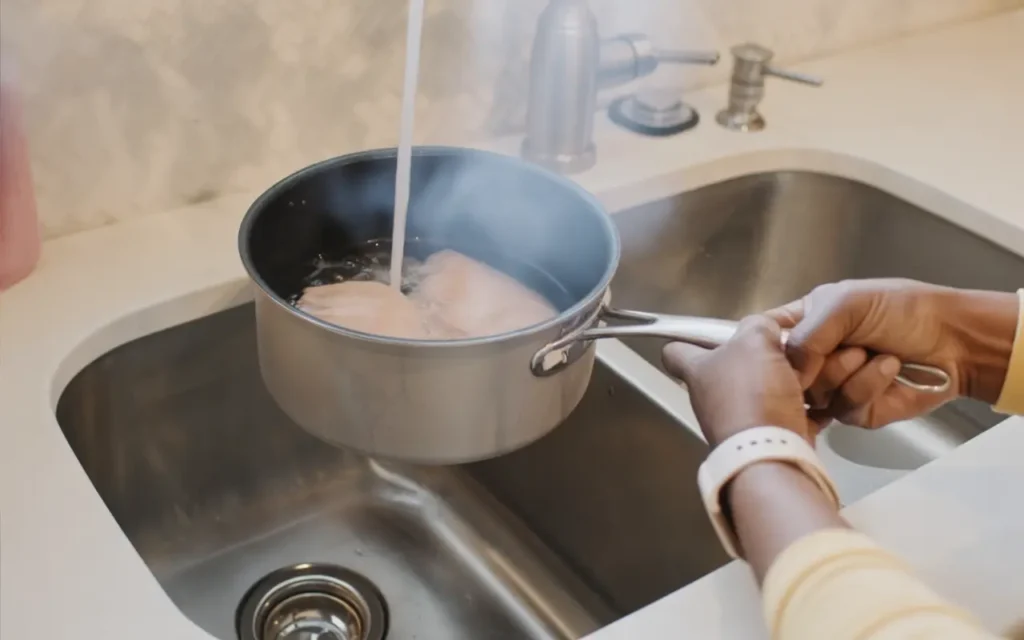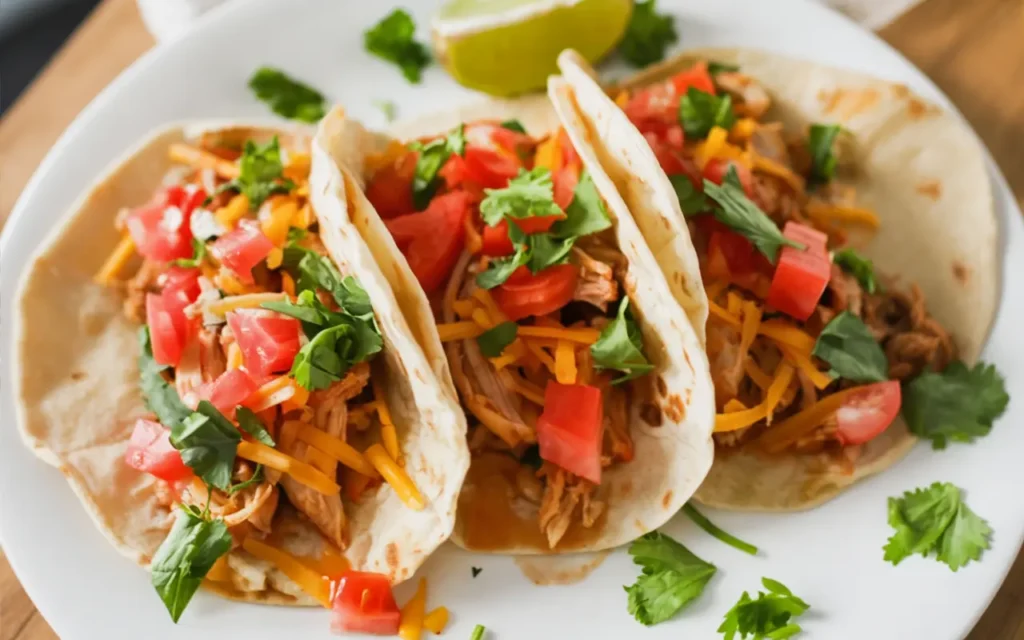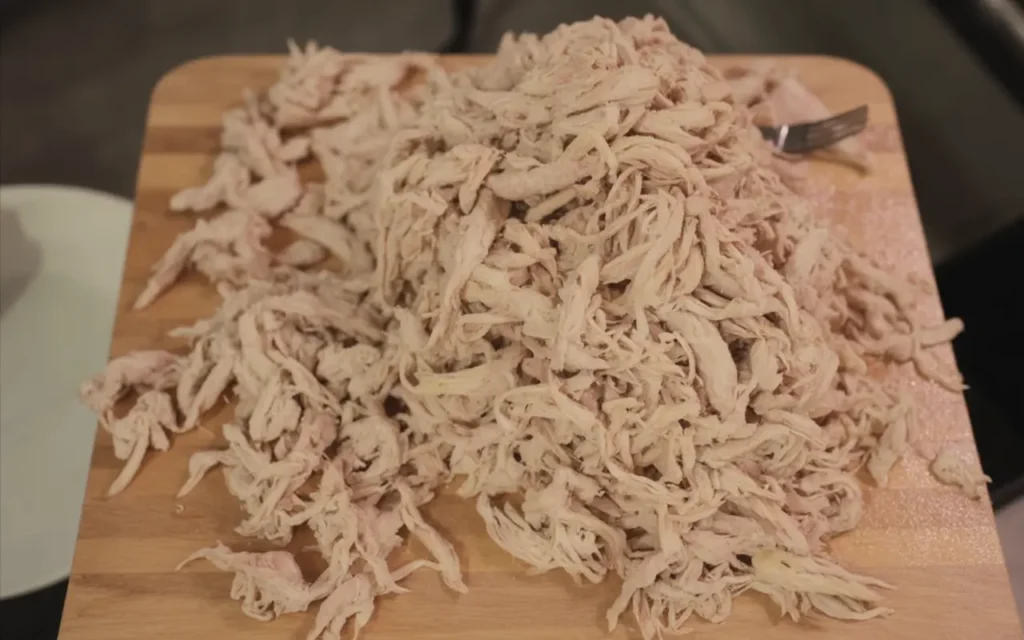Boiling chicken breast is one of the easiest ways to cook chicken. It is fast, healthy, and gives you juicy chicken breast that you can use in many meals. You can add it to salads, sandwiches, pasta, or save it for meal prep during the week. I like this method because it needs no oil and keeps the chicken light and healthy.
There is a big difference between boiling and poaching. If you boil chicken too hard, it can turn tough and rubbery. Poaching means cooking the chicken slowly in hot water or broth. This gentle simmer keeps the chicken tender and full of flavor. I once made the mistake of boiling too fast, and my chicken turned out dry and chewy—so I learned to always keep the heat low.
Now, when I simmer the chicken, it comes out soft, juicy, and easy to shred. It tastes much better and works well in any recipe. If you cook chicken often, learning this simple method will help you make perfect chicken breast every time.
What You Need to Boil Chicken Breast
You only need a few simple ingredients to boil chicken breast. Start with fresh or thawed chicken breasts. Water works fine, but chicken broth makes the chicken taste better. You can also add garlic, onion, herbs, salt, and pepper for more flavor. Sometimes I add a bay leaf or a piece of onion, and it gives the broth a nice smell.
The right tools also make cooking easier. Use a large pot or Dutch oven so the chicken has space to cook evenly. A lid helps keep the heat inside while the chicken simmers. An instant-read thermometer is important too. Chicken is safe to eat when it reaches 165°F (74°C) in the thickest part. I always check mine so I don’t overcook it.
When I first boiled chicken, I only used water and a little salt. It came out plain and a bit dull. Later, I tried adding garlic, onion, and herbs, and the taste was much better. These small changes make a big difference, especially if you are making chicken for meal prep.
Step-by-Step Guide: How to Boil Chicken Breast

1. Prepare the Liquid
- Place chicken breasts in a pot in a single layer.
- Cover with water, chicken stock, or broth for extra flavor.
- Add simple seasonings like garlic, peppercorns, onion, or bay leaf.
- I often use low-sodium chicken stock because it gives the chicken a rich taste without being too salty.
2. Bring to a Gentle Boil
- Heat the pot on medium-high until the liquid starts to boil.
- Once it boils, lower the heat to a gentle simmer.
- Simmering (not rapid boiling) keeps the chicken tender instead of tough.
- From my experience, if you keep it at a rolling boil, the chicken turns rubbery — so always simmer.
3. Cooking Time
- Thin cutlets: 8–10 minutes.
- Boneless chicken breasts: 12–15 minutes.
- Bone-in chicken breasts: 20–30 minutes.
- I usually set a timer to avoid overcooking because even 2–3 extra minutes can make the meat dry.
4. Check Doneness
- Use a food thermometer for accuracy — chicken is safe at 165°F (74°C) (USDA guideline).
- Cut into the thickest part; the meat should be white, with no pink inside.
- If you’re boiling more than one piece, check each breast, since sizes cook differently.
- Personally, I never skip the thermometer — it takes the guesswork out.
5. Rest Before Cutting
- After cooking, remove chicken and let it rest for 5–10 minutes.
- Resting helps the juices settle back into the meat, keeping it moist.
- Slice or shred only after resting for the best texture.
- From trial and error, I learned this step makes all the difference — skip it, and the chicken feels dry.
Tips for Juicy and Flavorful Boiled Chicken

- Use broth instead of water
Cooking chicken in chicken broth gives it more flavor. Water works too, but broth makes the meat taste richer and less plain. I’ve found that when I use broth, the chicken comes out moist and full of flavor without needing much extra seasoning. - Add aromatics like garlic, onion, and herbs
Simple ingredients like garlic, onion, celery, or bay leaves can change the taste in a big way. These add a gentle flavor to the chicken and the liquid. I always toss in fresh herbs like parsley or thyme because they make the chicken smell and taste fresh. - Keep the heat low
If the water boils too hard, the chicken can turn rubbery. A gentle simmer helps keep the chicken tender and juicy. I usually set the heat just high enough to see small bubbles, and that’s when I know it’s cooking the right way. - Cover the pot while simmering
Covering the pot traps steam and heat, which helps cook the chicken evenly. This also keeps the meat from drying out. I’ve noticed that when I leave the pot uncovered, the broth reduces too fast and the chicken isn’t as moist.
How to Shred, Slice, or Dice Boiled Chicken

Shredding chicken is simple and handy for meals like tacos, soups, and salads. I like to use two forks and pull the chicken apart while it’s warm. Warm chicken shreds faster and stays tender. Shredded chicken is perfect for tacos because it soaks up the flavor of salsa or sauce, making every bite taste fresh.
Slicing is best when you want chicken for sandwiches or wraps. I use a sharp knife to cut thin, even slices. The slices fit well on bread and stay neat in a wrap. Sliced chicken also works nicely in a salad when you want bigger pieces instead of small bits. Adding herbs or olive oil keeps it juicy and tasty.
Dicing is great for casseroles, pasta, or rice dishes. I cut the chicken into small cubes so it mixes well with the other ingredients. Diced chicken picks up flavors quickly from sauces or seasonings. I often dice extra chicken and keep it in the fridge. It makes cooking on busy nights faster and easier.
How Long to Boil Chicken Breast?
When boiling chicken breast, the cooking time depends on whether it is boneless, bone-in, or frozen. Boneless chicken usually takes 12–15 minutes, while bone-in pieces need closer to 20 minutes. If you are cooking frozen chicken, give it at least 20–25 minutes. I often keep a meat thermometer handy and cook until the chicken reaches 165°F (74°C) to make sure it’s safe and juicy.
The thickness of the chicken breast also plays a big role in timing. A thin cut cooks faster and may be ready in under 10 minutes. Thicker breasts take longer and need extra minutes to cook through. I like to slice thicker chicken breasts in half before boiling—it saves time and makes the meat more tender.
From experience, I’ve learned it’s better to check doneness instead of just watching the clock. Cutting into the thickest part should show no pink, and the juices should run clear. This works for any dish, whether you’re making shredded chicken for tacos, diced chicken for casseroles, or sliced chicken for sandwiches.
Should You Boil Chicken Covered or Uncovered?
When you cover chicken while boiling, the heat stays inside the pot, which makes the chicken cook faster and stay moist. I often use this method when I’m short on time or want tender chicken for salads and pasta dishes. Covering the pot also helps keep the kitchen a little cooler since steam doesn’t escape as much.
On the other hand, when you boil chicken uncovered, the liquid slowly reduces, which gives the broth a stronger flavor. I sometimes leave the pot uncovered if I plan to use the cooking water for soups or sauces, since it tastes richer this way. The chicken might take a little longer to cook, but the payoff is deeper flavor in the broth.
From my own kitchen, I’ve found that both methods have their place. If I need juicy chicken quickly, I keep the lid on. If I want a flavorful broth for noodle soup or risotto, I leave it uncovered. The key is knowing what dish you’re making and choosing the method that fits best.
Boiled vs. Poached Chicken
| Feature | Boiling | Poaching |
| Heat Level | High heat, rolling boil | Gentle simmer, low heat |
| Texture | Can turn dry and tough if overcooked | Juicy, tender, and soft |
| Best For | Shredding for soups, stews, or casseroles | Salads, sandwiches, or eating plain |
| Flavor | Mild, sometimes bland if not seasoned | Absorbs flavor from herbs, broth, or spices |
| Personal Note | When I boiled chicken too quickly, it lost moisture and wasn’t as tasty. | Poaching always keeps my chicken moist and flavorful—perfect for light meals. |
Common Mistakes to Avoid
Overcooking
One of the biggest mistakes is cooking chicken for too long. When you overcook, the meat turns dry and chewy. I remember the first time I boiled chicken, I left it on the stove a little too long, and it tasted like rubber. The key is to stop cooking once the chicken reaches 165°F (74°C). Using a meat thermometer can save you from this mistake.
Boiling too vigorously
Many people think fast boiling means faster cooking, but it actually ruins the chicken. Rapid boiling makes the meat tough and stringy. Instead, keep the water at a gentle simmer. I’ve found that low heat gives me tender chicken every time. Think of it as letting the chicken “bathe” instead of “fight” the water.
Skipping the rest time
Just like steak, chicken needs a short rest after cooking. If you cut it right away, the juices run out and the meat becomes dry. I usually let boiled or poached chicken sit for 5 minutes before slicing. This small step makes a huge difference in how juicy the chicken tastes.
Not seasoning the liquid
Plain water will not give much flavor. Adding salt, pepper, garlic, onion, or even herbs to the cooking water makes the chicken taste much better. Once, I skipped seasoning the liquid, and the chicken came out bland. Since then, I always treat the water like a light broth for extra flavor.
Storage and Meal Prep Tips
Refrigerating boiled chicken (3–4 days)
After boiling chicken, let it cool before putting it in the fridge. Use a clean, airtight container so it stays fresh for 3–4 days. I usually cook extra on Sunday and keep it ready for quick meals like wraps or rice bowls. The USDA says cooked chicken should always be stored at 40°F (4°C) or lower to stay safe.
Freezing boiled chicken (2–3 months)
If you want to save chicken for longer, freezing is best. Cut or shred the chicken, then place it in freezer bags or airtight boxes. I press out as much air as I can so it doesn’t get freezer burn. Writing the date on the bag helps me remember to use it within 2–3 months.
Best ways to reheat without drying out
Chicken can dry out fast if you reheat it the wrong way. I like to add a little broth or water before microwaving and cover it with a lid or damp paper towel. On the stove, warming it slowly with a bit of oil or sauce also works well. Heat it just until warm—too much heat makes it tough and chewy.
FAQs (Frequently Asked Questions)
Do you put chicken in before or after water boils?
It’s best to place the chicken in cold water first, then bring it to a boil. This way, the chicken cooks more evenly and stays juicy inside. If you drop it straight into boiling water, the outside can get tough while the inside cooks slower. I’ve tested both ways, and starting with cold water always gave me tender results.
Can you boil frozen chicken breasts?
Yes, you can boil chicken straight from frozen, but it takes longer. On average, frozen chicken breasts need about 15–20 minutes more than thawed ones. Always check the inside with a food thermometer—165°F (74°C) is safe. I often do this when I forget to thaw, and it works perfectly if you’re patient.
How to keep boiled chicken moist?
The secret is not to overcook. Once the chicken hits the safe temperature, remove it from the water right away. Adding a little salt or even onion, garlic, or herbs to the water also helps keep flavor and moisture. I usually cover the pot while simmering, which locks in steam and prevents the chicken from drying out.
What to do with leftover cooking liquid?
Don’t throw it out—it’s basically homemade chicken broth. You can use it for soups, rice, sauces, or even to cook vegetables. I often freeze small portions of it in containers, so I have broth ready whenever I need extra flavor in meals. It’s a simple way to save money and reduce food waste.
Conclusion
When it comes to the best way to boil chicken breast, the key is keeping it simple. Start with water or broth, add your chicken, and let it simmer gently instead of boiling hard. This helps the meat stay juicy and tender every time. I’ve tried rushing the process before, and it always ended up with dry chicken—so trust me, patience is worth it.
If you’re looking for a healthy chicken cooking method, this one is hard to beat. Boiling doesn’t need oil, and using broth adds flavor without extra calories. I always encourage people to try the gentle simmer technique—it’s easy, forgiving, and works even if you’re not an experienced cook. Once you do it a few times, it becomes one of those go-to skills you’ll always rely on.
